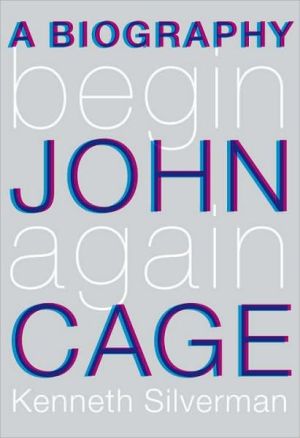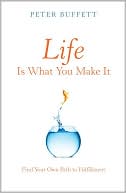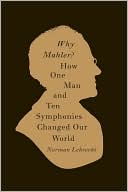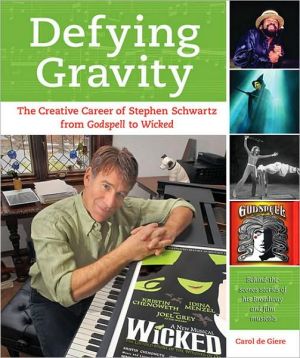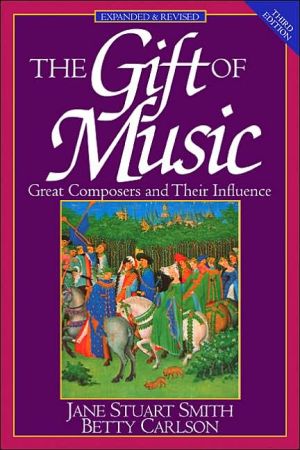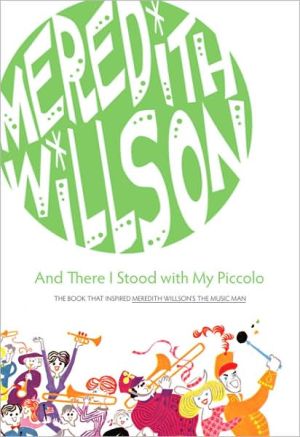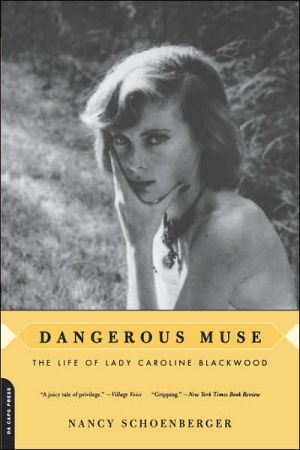Begin Again: A Biography of John Cage
A man of extraordinary and seemingly limitless talents—musician, inventor, composer, poet, and even amateur mycologist—John Cage became a central figure of the avant-garde early in his life and remained at that pinnacle until his death in 1992 at the age of eighty. Award-winning biographer Kenneth Silverman gives us the first comprehensive life of this remarkable artist. Silverman begins with Cage’s childhood in interwar Los Angeles and his stay in Paris from 1930 to 1931, where immersion in...
Search in google:
John Cage was a man of extraordinary and seemingly limitless talents: musician, inventor, composer, poet. He became a central figure of the avant-garde early in his life and remained at that pinnacle until his death in 1992 at the age of eighty. Now award-winning biographer Kenneth Silverman gives us the first comprehensive life of this remarkable artist. We follow Cage from his Los Angeles childhood—his father was a successful inventor—through his stay in Paris from 1930 to 1931, where immersion in the burgeoning new musical and artistic movements triggered an explosion of creativity in him and, after his return to the States, into his studies with the seminal modern composer Arnold Schoenberg. We see Cage’s early experiments with sound and percussion instruments, and watch as he develops his signature work with prepared piano, radio static, random noise, and silence. We learn of his many friendships over the years with other composers, artists, philosophers, and writers; of his early marriage and several lovers, both female and male; and of his long relationship with choreographer Merce Cunningham, with whom he would collaborate on radically unusual dances that continue to influence the worlds of both music and dance.Drawing on interviews with Cage’s contemporaries and friends and on the enormous archive of his letters and writings, and including photographs, facsimiles of musical scores, and Web links to illustrative sections of his compositions, Silverman gives us a biography of major significance: a revelatory portrait of one of the most important cultural figures of the twentieth century. Library Journal In anticipation of the centenary in 2012 of John Cage's birth, award-winning biographer Silverman (Lightning Man: The Accursed Life of Samuel F.B. Morse) has produced the first in-depth, detailed account of Cage's rich and colorful life. His numerous, passionate, and complex relationships with the leading minds of the American and European avant-garde artistic movements are carefully chronicled and, in toto, would convince any doubters that Cage should rightly be regarded as one of the most original and influential thinkers of the 20th century. Silverman's prose is lively and occasionally mirrors Cage's own wit. There are a few small illustrations of Cage's scores, including a page of his famous aria, and several textcentric, mesostic pieces. Compared with Kyle Gann's recent No Such Thing As Silence: John Cage's 4'33", this book contains a much more complete view of Cage's entire life and works, though it doesn't delve as deeply into the philosophical underpinnings of his signature work. VERDICT This excellent, thoroughly researched biography is an essential purchase. Highly recommended. [See Q&A with Silverman, p. 110.]—Larry Lipkis, Moravian Coll., Bethlehem, PA
Chapter 1\ COMES UP FAMOUS\ —headline, Los Angeles Times\ 1912–1937\ The Cage Family; Los Angeles High School;\ Pomona College\ John Cage’s achievement, the Times observed, was “a matter of pride to the people of California.” A front-page photo showed Cage waving to ten thousand spectators who had gathered to cheer him, including the mayor of Los Angeles. Telegrams announcing his triumph had been sent to President Woodrow Wilson.\ Coming up famous on June 11, 1913, John Milton Cage and his crew of five had stayed underwater more than twenty-four hours, doubling the world record for submergence. The seventy-five-foot-long vessel—named Peace Keeper—had been built under his patents, as general manager of the Los Angeles Submarine Boat Company. When tested six months earlier, the Peace Keeper sank due to shifting ballast and an open hatchway. It had to be raised off the bottom of Los Angeles Harbor and dragged through mud back to its slip, to be pumped out.\ The Times assessed the launching of “the Cage submarine” as “one of the most important events that has ever occurred in California or the entire country.” It was believed in Washington that submarines would be key weapons in future wars (such perhaps as World War I, to break out one year later). And Cage had invented novel devices to keep his sub level, increase its speed, and greatly improve its safety by running the engines on gasoline rather than potentially explosive storage batteries. A rear admiral of the U.S. Navy predicted that it would replace all other submarines in use. Not to mention, as John Cage boasted, that his Peace Keeper was the only sub in which the underwater crew could smoke.\ About twenty-seven years old at the time, John Milton Cage had been born in Los Angeles, the son of a Methodist minister. His formal education ended with graduation from a high school in Denver. As he later wrote, he remained concerned with “radical advances in thinking,” with overthrowing “traditional patterns?.?.?.?we have acquired through years of hard work at school.” At a church in Denver he had met his wife, Lucretia, known as Crete. A diminutive, dark- haired woman, a few months older than her husband, she had been married once before, possibly twice. Much concerned with genealogy, she traced his ancestry to pre-Revolutionary Virginia, and her own Iowa family to Daniel Boone. The couple had had a child, whom they named John Milton Cage. But he survived only two weeks. Then on September 5, 1912—about nine months before the triumph of Peace Keeper— Lucretia gave birth in Los Angeles to another son. The couple again named him John Milton Cage, Jr.\ Cage Jr. and his parents moved several times during his childhood and youth. For a while John Sr. took the family to Detroit, where he worked on automobiles and patented some improvements for internal- combustion engines. While in Michigan, Crete sustained her interest in the American past by starting a Lincoln study club. Mostly the family lived in various parts of Southern California—Long Beach, Santa Monica, Ocean Park.\ Young John Cage, Jr., was smart, sensitive—and inventive. At Ocean Park he spent mornings on the beach building roller coasters in the sand, with tunnels and inclines on which he could roll a small rubber ball. He was also pious. When the family moved to a vine-covered bungalow in Eagle Rock, an elevated part of Los Angeles, Lucretia’s parents lived with them. Cage remembered his grandmother as a “very self-righteous” woman whose main question in life was “are YOU ready for the second coming of the Lord.” After dinner, before going to bed, he read Bible verses with her.\ Such reading played a part in young Cage’s early education. He later remembered his time spent in elementary school as dismal. A precocious boy, he got beaten up by other children in his grade, who considered him a sissy. For religious reasons he never defended himself, taking seriously the injunction to turn the other cheek. His musical education began at about the time he reached fifth grade. When living in Santa Monica he took piano lessons from a nearby teacher. When the family moved close to Glendale, they bought him a piano and he studied with his mother’s sister, Aunt Phoebe James. A singer, pianist, and piano teacher, she taught him to sight-read. She held recitals at which her students performed ‘Pianologues.’ Costumed, they played and at the same time read aloud a short story. For a while John Jr. imagined devoting his life to performing the piano works of Grieg, which he found not too difficult, and loved.\ In his early teens, during the mid-1920s, Cage Jr. grew seriously interested in radio. He was not alone. His father invented a crystal set that could be plugged into an ordinary electric light system; the 1926 Los Angeles city directory listed him as a “radio engineer.” The same years also brought the organization of the National Broadcasting Company and the first international radio broadcast, between London and Maine. John Jr. got the idea of hosting a radio program for the Boy Scouts. A Tenderfoot himself, he obtained permission from the organization and the approval of station KNX to broadcast a weekly show Friday afternoons. The performing Scouts spoke about their experiences building fires and tying knots. They also sang, John Jr. sometimes accompanying them on the piano. Now considering himself destined for the ministry, he began each program with an inspirational ten-minute talk by some minister, rabbi, or other notably religious person. During the two years his show stayed on the air, the volume of fan mail increased every month.\ Already a serious reader, John Jr. refined and expanded his literary interests as he graduated to Los Angeles High School. His Latin teacher reportedly praised the excellence of his translations of Virgil. He studied some Greek as well, and became a contributing editor of the school’s French newspaper. As a senior he represented Los Angeles High in the Southern California Oratorical Contest at Hollywood Bowl. His clear, effective speech concerned relations between the United States and Latin America, a subject much in the news. In 1925, U.S. troops entered the Panama territory to quell a labor revolt; next year marines landed in Nicaragua to subdue an insurrection. Cage Jr. argued that Uncle Sam had rid many countries of the curse of revolution and protected them from European domination. On the other hand, some American capitalists selfishly exploited the southern republics, which view these profiteers as representing the United States. To prove that “man can surpass misunderstanding,” he called on Latin Americans to accept America’s help in making themselves fit for self-government and on American capitalists to “cleanse our hands of gold-dust.”\ Young Cage’s speech won the oratorical contest, and he graduated Los Angeles High as class valedictorian. The school yearbook characterized seniors by letters of the acrostic ROMAN. For his R(ecreation) he received “orating”; for A(spiration) he got “to earn a D.D. and Ph.D.”; and for N(oted for) he received a quite John Cage, Sr.–like “being radical.” Despite thoughts of becoming a Methodist minister, he grew attracted at this time to the Liberal Catholic church in the Hollywood Hills. He liked what he remembered as the theatrical bits of its rituals—candles, processions, clouds of incense—and decided to become an acolyte in the church. His parents strenuously objected, however, and he gave up the idea.\ Having excelled in high school and skipped some grades, Cage Jr. entered Pomona College the same month that he turned sixteen. But his college career was brief and without academic distinction. The future Doctor of Divinity earned only a B in Orientation to Religion, with Cs in gym, sports, and choir. He received As only for an introductory English course and for English Short Story Writing. Under the name “Jonathan Cage” (to distinguish himself from his father?), he published a short story in the school’s literary magazine, Manuscript. Entitled “The Immaculate Medawewing,” it featured a young aesthete named Verlaine who abhors dirt in whatever form—sticky carpets, rotten eggs, dandruff. Verlaine’s young female friend Elicia tries to convince him that his worship of cleanliness has kept him “beauty- blind,” unable to appreciate certain forms of art. He tries to alter his tastes but fails, unable to accept a sandwich crawled by flies.\ John Jr. also published a delicate nine-line poem entitled “Song Ghosts.” The subject—ambient sound—would become of urgent importance to him:\ And there’s a song\ That’s in the air; that growing\ Floats forever far: a weak,\ Yet swinging, flowing, swaying melody.\ The college newspaper identified him as a “prominent campus writer.” But despite his literary successes, his experiences at Pomona left him, like his father, disenchanted with education. After two years at college he dropped out. He not only dropped out. The seventeen-year- old roller-coaster builder, Grieg pianist, radio personality, disappointed Liberal Catholic acolyte, short-story writer, and poet took off—hitchhiking to Houston, then taking a boat to Le Havre.
1 · COMES UP FAMOUS...................................................................................3\ 2 · THE ART OF NOISE.........................................................................................26\ 3 · EAST AND WEST...................................................................................................51\ 4 · MUSIC OF CHANGES...................................................................................79\ 5 · THE TEN THOUSAND THINGS....................................................121\ 6 · INDETERMINACY.............................................................................................152\ 7 · FRACTURES...............................................................................................................182\ 8 · HPSCHD.........................................................................................................................210\ 9 · EMPTY WORDS.................................................................................................244\ 10· APARTMENT HOUSE..................................................................................275\ 11 · CHANGES AND DISAPPEARANCES...................................302\ 12 · TIME BRACKETS.................................................................................................324\ 13 · EUROPERAS...............................................................................................................351\ 14 · ANARCHIC HARMONY.........................................................................382\ 15 · 1992......................................................................................................................................401\ DOCUMENTATION............................................................................................415\ ACKNOWLEDGMENTS................................................................................455\ ILLUSTRATION CREDITS.............................................................................457\ TRACK CREDITS....................................................................................................459\ INDEX.................................................................................................................................461
\ Library JournalIn anticipation of the centenary in 2012 of John Cage's birth, award-winning biographer Silverman (Lightning Man: The Accursed Life of Samuel F.B. Morse) has produced the first in-depth, detailed account of Cage's rich and colorful life. His numerous, passionate, and complex relationships with the leading minds of the American and European avant-garde artistic movements are carefully chronicled and, in toto, would convince any doubters that Cage should rightly be regarded as one of the most original and influential thinkers of the 20th century. Silverman's prose is lively and occasionally mirrors Cage's own wit. There are a few small illustrations of Cage's scores, including a page of his famous aria, and several textcentric, mesostic pieces. Compared with Kyle Gann's recent No Such Thing As Silence: John Cage's 4'33", this book contains a much more complete view of Cage's entire life and works, though it doesn't delve as deeply into the philosophical underpinnings of his signature work. VERDICT This excellent, thoroughly researched biography is an essential purchase. Highly recommended. [See Q&A with Silverman, p. 110.]—Larry Lipkis, Moravian Coll., Bethlehem, PA\ \ \ \ \ Kirkus ReviewsA Bancroft and Pulitzer Prize winner takes on one of the most influential composers of the 20th century.\ John Cage (1912–1992) redefined what music could be by expanding nearly every element of the art. Silverman (Lightning Man: The Accursed Life of Samuel F.B. Morse, 2003, etc.) traces his innovations chronologically—his breakthrough years as a composer of experimental dance and percussion music, his definitive decade inventing chance-derived music as a member of the New York School of artists and musicians in the '50s, and his later development of indeterminate music, the content of which could be created by the performer. Cage's originality and his subsequent influence spread far beyond music into the visual arts and poetry, playing a central role in the creation of the Fluxus movement as well as the Language school of poetry. Silverman's prose gracefully captures the seamlessness of Cage's effect on 20th-century creative art, and he provides a careful, but not uncritical, exploration of the composer's personal relationships, many of which involved men and women who would become monumental artists, scientists and thinkers. The author also explores other parts of Cage's life, including his interest in chess, which he learned to play from Marcel Duchamp, and his work as a mycologist.Silverman also provides a much-needed corrective to a generation of artists and musicians who have idolized, even mythologized Cage, yet grossly misunderstand or remain ignorant of what Cage actually accomplished as a composer. As someone who experimented quite dramatically with musical notation, instrumentation and the very nature of what sound could be—think of his famous "silent" piece,4'33"—Cage occasionally mystified the very music he sought to simplify. Yet Silverman's artful narrative lays bare Cage's compositional processes, aesthetic posturing and the cross-cultural philosophical underpinnings to his work with a clarity that musicologists and art historians have yet to achieve.\ Not just an exemplary biography, but a significant contribution to the cultural history of American music.\ \ \
